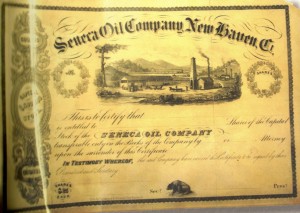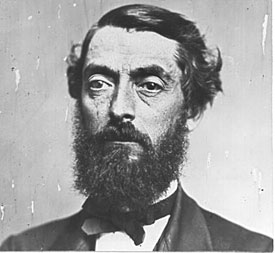Biography of father of U.S. oil industry reaches total depth.
In August 1859, the man who would launch America’s petroleum industry was down to his last pennies — and a letter was on its way to “Colonel” Edwin L. Drake telling him to cease drilling at Titusville, Pennsylvania. Investors in the first oil company wanted him wanted out.
“As far as the company was concerned, the project was finished,” notes historian William Brice, PhD, in his 2009 biography of Drake, a former railroad conductor. “Fortunately that letter was not delivered until after they found oil.”
The Seneca Oil Company of New Haven, Connecticut, seeking oil for refining into the lamp fuel kerosene, wanted to impress stockholders and local businesses by referring to Drake as “Colonel” in company correspondence. But after a year and a half of difficult drilling with steam-powered cable tools, Drake and his driller “Uncle Billy” Smith had reached a depth of less than 70 feet.

The 2009 biography of the father of America’s oil and natural gas industry was published during the 150th anniversary of the first U.S. oil well.
With Seneca Oil Company investors running out of patience, The drill bit at Drake’s exploratory well dropped into a crevice at 69.5 feet. When Smith inspected the well the following afternoon, Brice reports the driller “noticed a very dark liquid floating on top of the water in the hole, which, when sampled, turned out to be oil.”
Once labeled “Drake’s Folly,” the first U.S. oil well was not such a folly after all. “Drake had shown that large quantities of oil could be found by drilling into the earth,” notes Brice in Myth, Legend, Reality – Edwin Laurentine Drake and the Early Oil Industry. “And so began the modern petroleum industry.”
Brice was commissioned in 2007 to write the biography by the Oil Region Alliance in Oil City, Pennsylvania. Two years later, the professor emeritus in geology and planetary science at the University of Pittsburgh at Johnstown, completed his 661-page biography of Edwin Laurentine Drake.
The book was part of “Oil 150,” the 2009 sesquicentennial of the petroleum industry pioneer who successfully drilled a well specifically to find oil. It includes more than 200 pages of reference material and dozens of rare images.
“Bill dug through the history related to Drake as no one has before, and the result is a much more complete picture of the man, his family and his accomplishments,” proclaimed geologist and editor of the Oilfield Journal Kathy J. Flaherty.
Asked by the publisher for commentary, Bruce Wells of the American Oil & Gas Historical Society (AOGHS), praised Brice’s extensive research, oilfield technical knowledge — and skill at providing historical context.
“Myth, Legend, Reality – Edwin L. Drake and the Early Oil Industry is a well-written account of Drake and his times — and the history and significance of his 1859 discovery,” the AOGHS executive director noted.
Brice’s book includes little-known details about Drake, a shareholder of the Seneca Oil Company of New Haven, Connecticut, which acquired the Titusville leases of the Pennsylvania Rock Oil Company before the drilling attempt along Oil Creek.
“Bill Brice provides the careful research needed to sort out the nonsense and brilliance of the man who established the American petroleum industry,” the founder of AOGHS added.
A longtime resident of Johnstown, Pennsylvania, geologist Brice was a member of the faculty at the University of Pittsburgh at Johnstown from 1971 through 2005. He also was a visiting professor in earth and atmospheric sciences at Cornell University, 1976 to 2002.
Brice, a past president and longtime advocate of the Petroleum History Institute (PHI), in 2008 was awarded the Distinguished Service Award from the History of Geology Division of the Geological Society of America.

Seneca Oil Company of New Haven, Connecticut, drilled the first U.S. oil well after being reorganized from the Pennsylvania Rock Oil Company. Image courtesy William Brice/Pennsylvania Historical and Museum Collection.
The author has edited the PHI peer-reviewed journal, Oil-Industry History, and managed the group’s annual oil history symposiums and field trips. He frequently has lectured about Drake and the early U.S. petroleum industry.
“August 27, 1859, is one of those dates on which the world changed, Brice proclaimed in 2009. “Edwin Drake’s quest to find oil by drilling was a success, and the modern oil and gas industry took a giant leap forward.”
Even though the use of petroleum dates back to the first human civilizations, Brice added, “The events of that Saturday afternoon along the banks of Oil Creek near Titusville, Pennsylvania, provided the spark that propelled the petroleum industry toward the future.”
Learn more in First American Oil Well.
_______________________
Recommended Reading – Myth, Legend, Reality – Edwin Laurentine Drake and the Early Oil Industry (2009); The Birth of the Oil Industry (1936). Your Amazon purchases benefit the American Oil & Gas Historical Society.
_______________________
The American Oil & Gas Historical Society (AOGHS) preserves U.S. petroleum history. Please become an AOGHS annual supporter and help maintain this energy education website and expand historical research. For more information, contact bawells@aoghs.org. Copyright © 2025 Bruce A. Wells. All rights reserved.
Citation Information – Article Title: “Edwin Drake and his Oil Well.” Authors: B.A. Wells and K.L. Wells. Website Name: American Oil & Gas Historical Society. URL: https://aoghs.org/energy-education-resources/edwin-l-drake-oil-well. Last Updated: March 22, 2025. Original Published Date: August 1, 2009.




